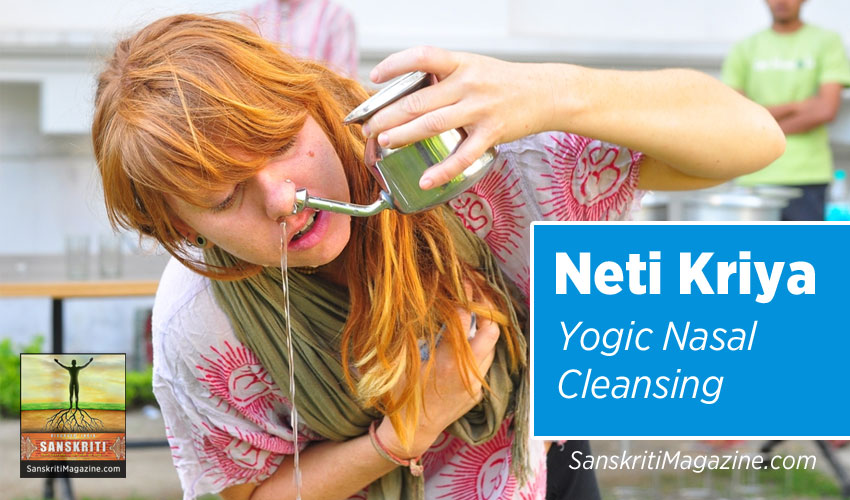Insert a soft thread through the nose to the length of one hand-span so that it comes out of the mouth. This is called neti by the siddhas.
~ (“Hatha Yoga Pradipika” 2:29)
Sutra Neti
The method of neti performed by passing a length of thread through the nose is called sutra neti. ‘Sutra’ means ‘thread’. A specially prepared thread has to be used. It should be made of cotton, not synthetic fibre, tightly wound together and then wiped with melted beeswax. The width should be about 4mm and the length 36cm. However, it is more convenient to use a thin rubber catheter lubricated with ghee so that it slides easily through the nasal passage. It is a good idea to practise jala neti first to make sure the nostrils are clear.
Preparing the thread
1. Cut a number of strands of the thread to about 45cm in length, so that the diameter of the strands when bundled together is about 3mm. You can increase this later according to the size of your nasal passages.
2. Heat some beeswax.
3. Hold the end of the bundle and trim it so that all the ends are even, and twist the end of the bundle.
4. Soak the first 12cm of the twisted end in the hot beeswax and allow it to harden into a stiff pliable cord. 5. Trim the ether end so that the total length of the cord is about 45cm. Twist about 10cm of the end and soak it in beeswax. Allow to harden.
Technique
Squat – tilt the head slightly back and insert the thread or catheter straight into the left nostril – the thread should not be forced through the nose but pushed gently so that it passes slowly down into the throat -when it reaches the back of the throat insert the first two fingers into the mouth and pull the thread out through the mouth leaving a few inches of thread hanging out of the nose – slowly and gently pull the thread backwards and forwards thirty to fifty times -remove it slowly and repeat through the opposite nostril – pranayama should be practised upon completion.
Advanced Stage
Having one end of the sutra emerging from the mouth and the other from the nose, push the end of the sutra coming from the nose into the other nostril and pull the end through the mouth – both ends now emerge from the mouth – loosen the wax so that the threads again become individual strands – merge the threads and twist the sutra so that the two ends become joined – the join should he sufficiently thin to pass through the nostrils- slowly draw the join into the mouth and through the nostrils until it is again outside but located between the entrance to the two nostrils – disconnect the join – the sutra now emerges through the nostrils and not the mouth- gently pull it to and fro – if there is the slightest discomfort stop immediately – only a few movements of the sutra are necessary at first – slowly build up from there – withdraw the sutra from the nose.
Jala Neti
For jala neti you require a special neti lota or pot has a nozzle designed specifically so that it will fit into the nostrils. It can be made of brass or any other suitable material so that it does not contaminate water. The lota should be filled with warm slightly salted water.
Technique
Stand squarely, legs apart, body weight evenly distributed between the feet – lean forward – tilt the head to the right side and place the lota’s nozzle in the left nostril – open the mouth slightly and breathe through the mouth only – keep the whole body relaxed and let the water pass out through the right nostril – when yon have used half the water, remove the lota, remain bending forward, centre the head and let the water run out of the nose – close the right nostril with the fingers and blow gently through the left nostril so that all the remaining water comes out – practise in the same way, the water through the right nostril. Throughout the whole practice keep breathing through the mouth and do not attempt to breathe through the nose. Do not blow the nose very hard, otherwise the remaining water may be pushed into the ears, and irritation of the sinuses and mucus membrane may result. Although you can practise neti squatting, it is better to stand. If you experience pain in the nose during the practice, the quantity of salt is incorrect. Too little salt will create pain while too much will cause a burning sensation.
Dugdha, Ghrita & Urine Neti
Instead of water you can use warm milk to practise dugdha neti, or warm ghee to practise ghrita neti. (If oil is used instead of ghee, it must be unconcentrated and with no added chemicals.) These two practices are classified as variations of jala neti. However, the most powerful form of jala neti a with urine. Though it is not mentioned in the hatha yoga texts, it is particularly useful fur curing inflammation of the nasal passages and sinuses, as well as bleeding.
Neti can be practiced every day if you are suffering from sinusitis, colds, insensitivity to smell, nosebleed, headache, eyestrain or eye infections, otherwise it is best to practise only twice a week. Those suffering from chronic haemorrhage should not attempt neti unless under expert guidance. It is advisable to practise bhastrika or kapalbhati pranayama after jala neti. This will dry the nose and generate heat in the nostrils.
Benefits
According to the “Hatha Yoga Pradipika” “Neti cleanses the cranium and bestows clairvoyance. It also destroys all diseases which manifest above the throat”. Both sutra and jala neti exert a profound physiological effect on the body, mind and personality. On the physical level, irrigation of the nasal mucosa removes accumulated mucus from the nostrils, associated passages and sinuses, allowing air to flow without obstruction. Neti also exerts a relaxing and irrigating effect upon the eyes by stimulating the tear ducts and glands. It also clears the entrance to the eustacian tubes in the nasopharynx and promotes drainage of the sinuses, preventing stasis of mucus and keeping them clean and functional.
Regular practise of neti maintains healthy secretory and drainage mechanisms of the entire ear, nose and throat area. This helps to ward off colds and coughs, allergic rhinitis, hay fever, catarrh and tonsillitis. It also gives resistance to various diseases of the ears, eyes and throat, such as myopia, tension headache due to eyes train, certain cases of deafness such as ‘glue cars’ and middle ear infections etc. Mouth breathing in children, leading to poor memory, concentration and development, is overcome by neti.
Neti relieves muscular tension of the face and nervous tics, and helps maintain facial youth and freshness. It releases emotional tension and is beneficial in anxiety, depression, epilepsy and hysteria, It promotes a balance between the left and right nostrils, and consequently the right and left hemispheres of the brain. This induces a state of harmony and balance throughout the entire central nervous system and the systems governing respiratory, circulatory, digestive and excretory function. The frontal lobes of the cerebrum, responsible for the higher mental faculties, begin to function, optimally.
It is stated that ‘perfection’ of neti bestows ‘divya drishti’ or clairvoyance. What is this ‘perfection’ and can it be attained by jala neti alone?
Swami Niranjan: Neti provides a state of mental clarity which is useful for the higher practices of yoga. It is not simply the act of pouring water through one nostril and making it come out through the other. It is not only a practice of putting a catheter through one nostril and bringing it out through the mouth. Rather, the physical practice of neti gives birth to an internal state of neti which is the flow of prana shakti in the three channels of ida, pingala arid sushumna. Once the flow in Ida and pingala is balanced, then the harmony of their two flows will accentuate the flow of sushumna. The awakening of sushumna will, in turn, be responsible for the development of higher mental faculties, leading towards the nature of genius, intuition and creativity.
The term ‘divya drishti’ means ‘divine vision’ and has been wrongly interpreted as ‘clairvoyance’. Clairvoyance represents a state of mental achievement whereas ‘divine vision’ is an experience of an awakened personality. The practice of neti helps in attaining the awakening of the inner personality with the regulation of ida, pingala and sushumna flow, ultimately resulting in the awakening of the chakras and of kundalini.
Do we always have to start neti through the left nostril or can we start through whichever nostril is flowing?
Swami Niranjan: Although some traditionalists hold the view that neti should always begin with the left nostril, and some hold the view that it should begin with the right nostril, it has been our experience that the performance of neti can and should be done with, whichever nostril is flowing at the time of practice. This facilitates entry of water and forces the blockage open.
We have seen that, when neti is performed with the nostril which is blocked, the water is not going to go in, and if it does go in it will be in drops or maybe a trickle. This will be a very time-consuming process. However, the nostril which is open provides an easier entry for the water within the nasal passage, and that water, once it enters, is able to force its way out through the other nostril much more easily.
~ Swami Niranjan











